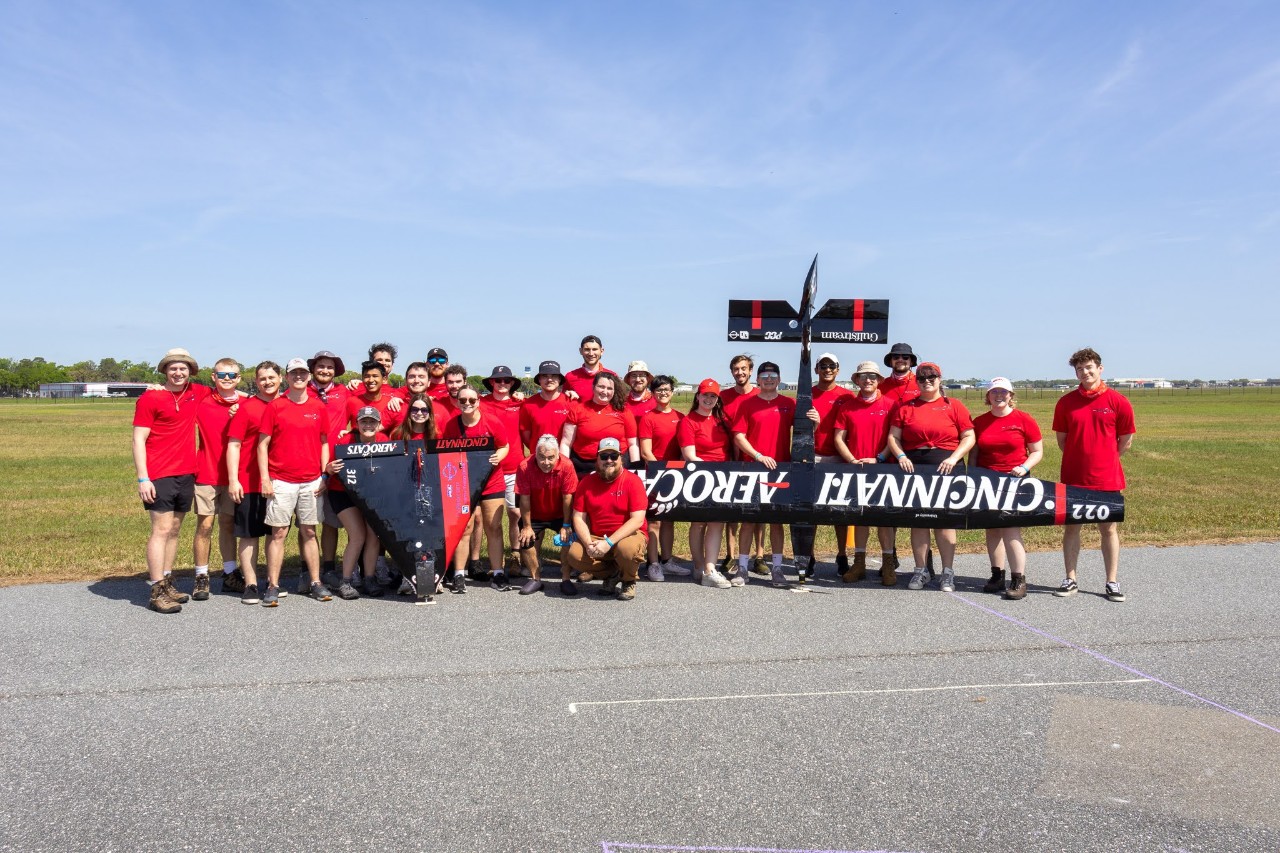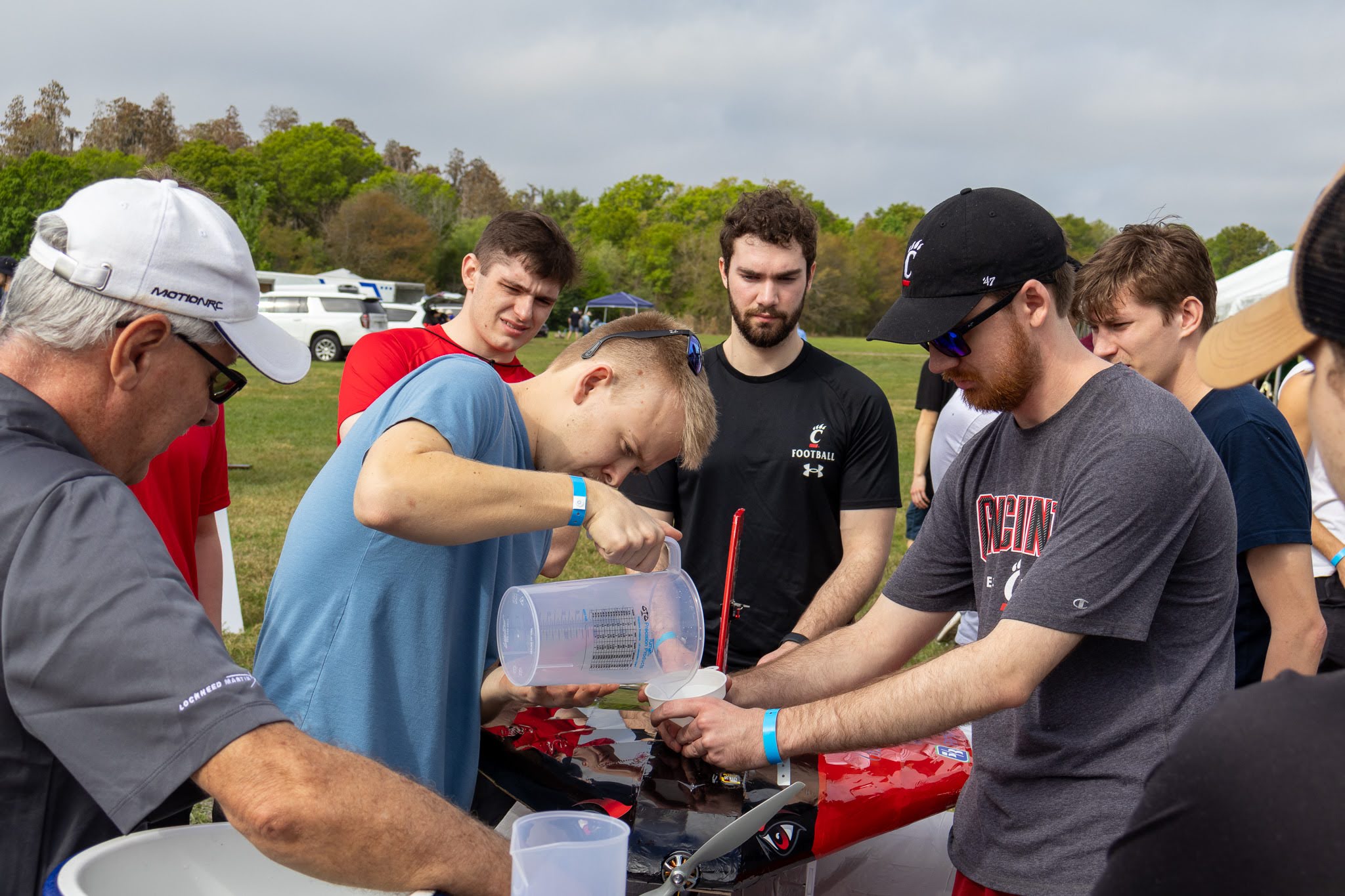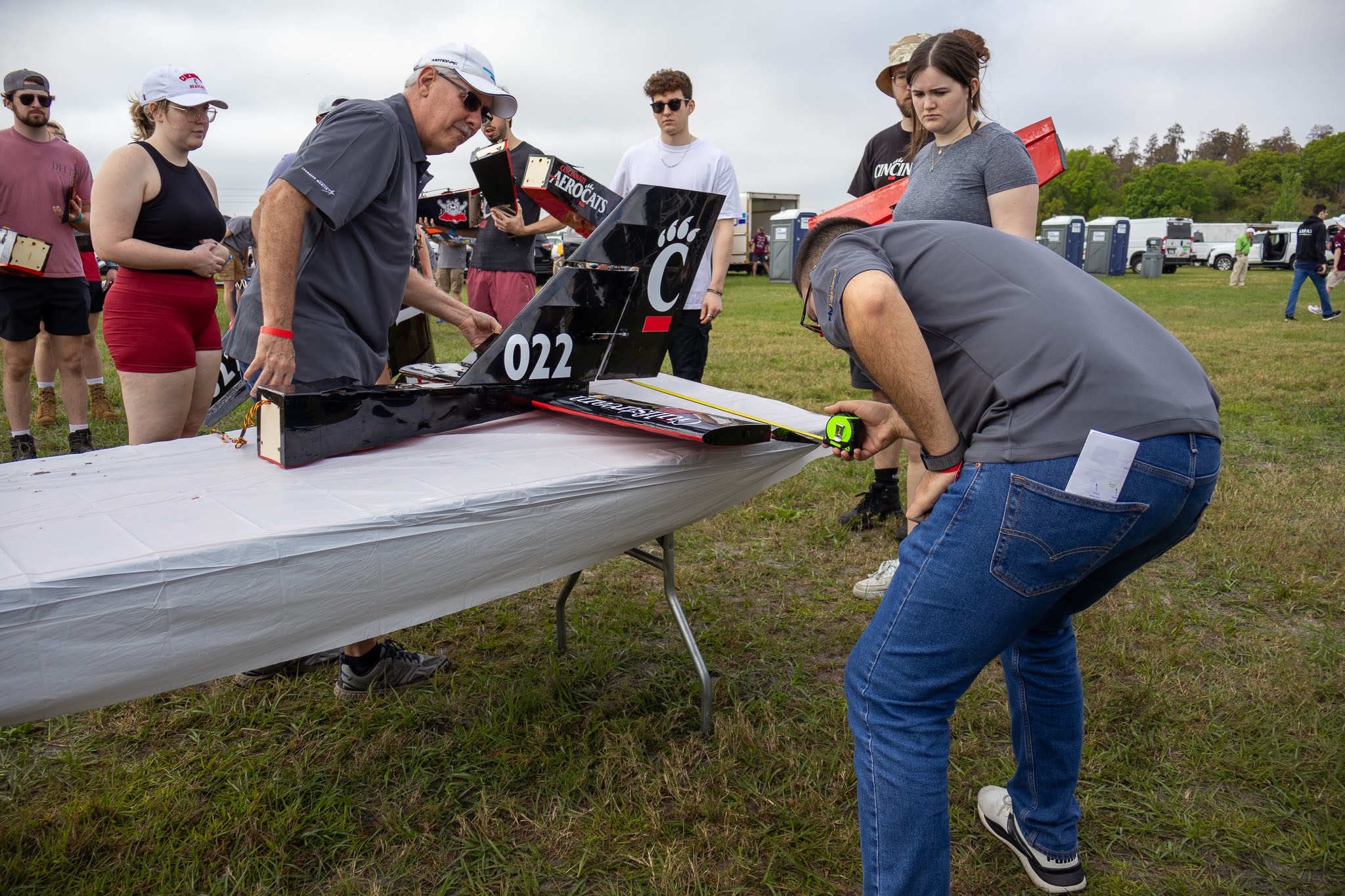
UC engineering students compete in aero design competition
The UC Aerocats team traveled to Florida to fly two aircraft
The University of Cincinnati has hundreds of student organizations, dozens of which are comprised mostly of engineering students. This spring, one of those student organizations, the UC Aerocats, flew two aircraft in the annual Society of Automotive Engineers International Aero Design competition.
At the College of Engineering and Applied Science, senior students are required to complete a cumulative capstone project that is a demonstration of the knowledge they gained through their five years of classroom and co-op experience. Some of these capstone projects are sponsored by student organizations, including Aerocats.

The Aerocats micro plane. Photo/provided
Dozens of senior aerospace engineering students chose Aerocats for their capstone project, which provided enough cumulative capacity for the group to build two aircraft instead of one. Students were designated as members of either the micro or regular aircraft teams. In both teams, students worked together to design, build, and fly an aircraft from scratch based on outlined requirements and restrictions.
To begin, the teams were given an equation based on four different factors to set a baseline for their design. However, the requirements for the aircraft were different based on category. For instance, in the regular category, teams must design an aircraft that can carry a certain payload, takeoff within a certain distance, and a new requirement this year: be sectioned into pieces that spanned no more than four feet.

For the 2024 Aero Design competition, regular aircraft were required to be sectioned into pieces spanning four feet or less. Photo/Provided
"The sectioning requirement was the main driver of our design for the airplane," said Gracynne Apke, project manager for the Aerocats regular team. "Not only did we have to worry about making a flyable airplane, we also had to figure out how we were going to break it apart while maintaining its functionality."
Apke shared that the team interpreted the sectioning requirement as the competition's way to throw in the types of challenges they will face in the real-world aerospace industry. Circumstances may not always be ideal, but must be complied with nonetheless.
For the micro category, a challenging requirement this year was that the plane needed to have a water tank capable of holding 67 ounces of water, and that it can be unloaded in less than one minute. The micro team faced a significant challenge during competition related to this water tank. Initially, they designed their plane to accomodate a full water tank. However, upon reading the fine print in the requirements, they realized the tank did not need to be full during flight.
"Our plane was larger than others because it was designed to hold the maximum weight possible with the water tank," said Andrew Eckert, project manager for the micro team. "Thanks to our design, we were able to fly the plane both full and empty, but if we were to redo it, we'd shrink down the plane to make it smaller."


Upon arriving in Florida for the competition, each aircraft went through technical inspection to ensure they were able to fly. Through technical inspection, aircraft were graded on the water tank and sectioning requirements for micro and regular, respectively, and judges confirmed that the blueprints submitted prior to the competition matched with the planes constructed by each team.
After passing technical inspection, the Aerocats were ready for flight.
You're going to have things go wrong in the real world and as a team you'll have to regroup and figure out how to solve the problem in front of you.
Andrew Eckert, UC Aerocats
Before they left for competition, the teams were able to run flight tests of their airplanes at an airfield in Dayton. This gave them an idea of what they might need to modify before competition and an expectation of how the planes would perform. Additionally, they were able to conduct test flights in Florida the day before the competition.
"When we went to competition, flying conditions weren't good," Apke said. "We had some crazy winds but were still able to get up in the air, which was awesome."
Despite the less-than-ideal weather, both the micro and regular teams had a successful competition. Micro placed first in the presentation portion, as well as fourth overall. The regular team placed seventh in flying performance and ninth overall. A successful competition is a testament to the hard work these students put in over the course of their final year at UC. From September to April, they worked on these aircraft, all while completing their other courses to graduate. Additionally, Aerocats received first place in this year's CEAS Expo Student Organization Sponsored category, another exemplification of their dedication.
"Aerocats is a great way to see something through from beginning to end. Through the years we taking classes relating to the construction of an airplane, but this gives insight into how those pieces all fit together," Apke said.

Prior to competition, the teams conducted flight tests to see how their plane would perform. Photo/provided
Along with allowing the students to combine what they've learned through their time at CEAS, this project was a great example of understanding how best to work in a team, how to problem solve, and how to work under a tight deadline.
"You're going to have things go wrong in the real world and as a team you'll have to regroup and figure out how to solve the problem in front of you," Eckert said. "Problem solving and team building was more beneficial when it comes to preparing to work in these real-world situations."
Aerocats, while an option for senior capstone projects, is open to students of all years. The team is looking for new members to maintain and build the group and its aircraft designs.
Featured image at top: The University of Cincinnati sent two aircraft to fly in the Aero Design competition in Florida. Photo/Provided
Related Stories
UC breaks summer enrollment record two years running
June 24, 2021
UC welcomes its largest summer class in university history by nearly 500 students. Preliminary summer 2021 enrollment is at 20,618 students, up 2.4% from 2020, when UC previously surpassed the university’s summer enrollment record. The upward trajectory represents a longtime trend in summer enrollment.
Mission possible: Perseverance and the path to Mars
March 26, 2021
As Perseverance hurtled toward its destination in February after years of preparation and a 7-month, 300-million-mile spaceflight, emotions ran deep among three recent University of Cincinnati graduates.
NASA co-op helps shape aerospace engineering student’s future
June 3, 2020
An aerospace engineering student from the University of Cincinnati’s College of Engineering and Applied Science is earning hands-on experience through a co-op internship at NASA Glenn Research Center. Kyle Dunlap hopes to take his experience in electrified aircraft propulsion control systems into his future engineering career.
